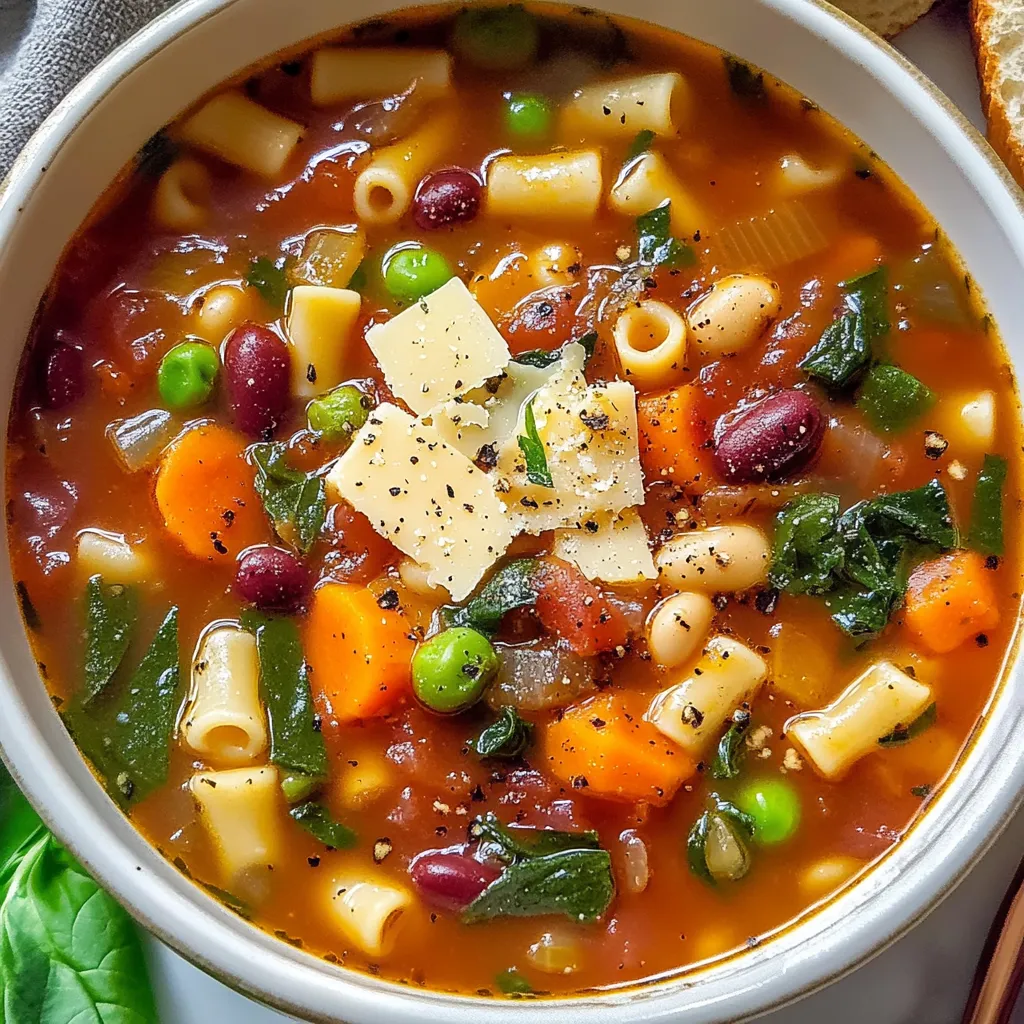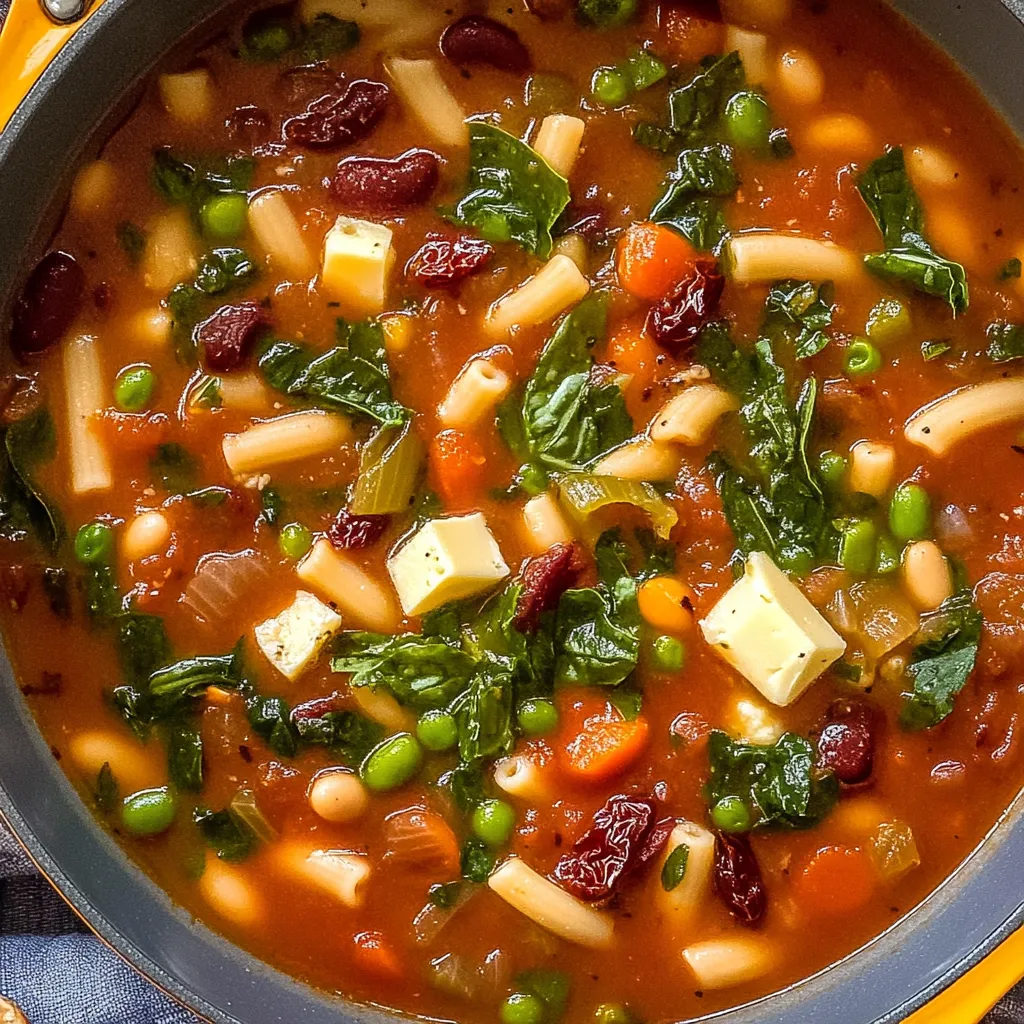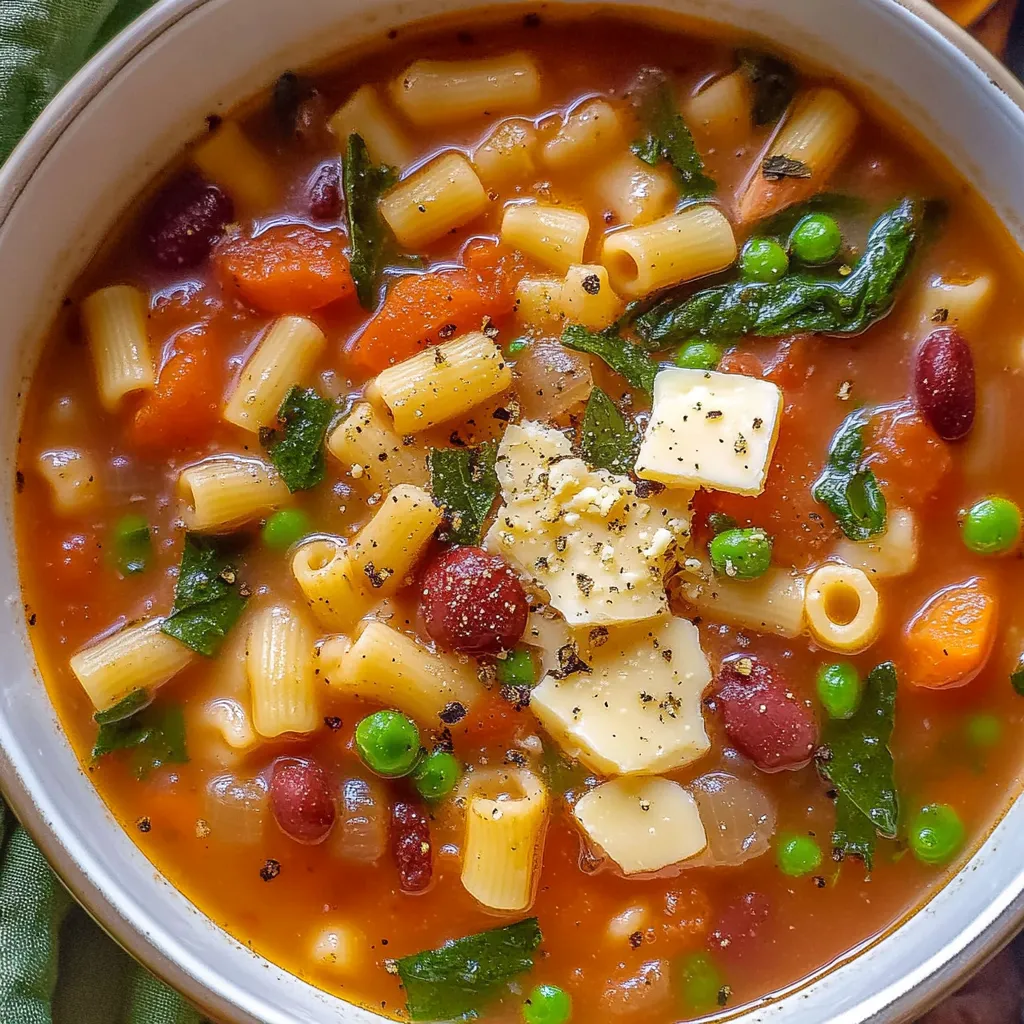 Pin it
Pin it
This classic minestrone soup has become my most-made recipe throughout fall and winter because it's the ultimate one-pot meal that's both incredibly healthy and deeply satisfying. The combination of vegetables, beans, and pasta simmered in rich tomato broth creates layers of Italian flavor that taste like you spent hours cooking when it's actually quite hands-off. I started making this when I learned it's a staple in Sardinia, one of the world's Blue Zones where people live the longest, and now my family requests it weekly because it's genuinely delicious comfort food that happens to be good for you.
My kids used to turn their noses up at vegetable soup until they tried this loaded with pasta and beans, and now they actually ask for "the Italian soup" without me having to convince them. Watching them happily slurp up spoonfuls of vegetables feels like a parenting victory.
Ingredients You'll Need
- Olive oil and butter: (for sautéing the vegetables) - The butter adds richness that mimics the creaminess a Parmesan rind would provide
- Onion, carrots, and celery: (diced, the classic sofrito base) - These three vegetables create the flavor foundation for Italian soups
- Fresh garlic: (two large cloves, minced) - Adds aromatic depth essential to Italian cooking
- Sun-dried tomatoes: (chopped, about a quarter cup) - Provides tangy, umami richness that compensates for not using Parmesan rind; tomato paste substitutes
- Dried oregano and basil: (about a teaspoon each) - Brings classic Italian herb flavor without needing fresh herbs
- Canned diced tomatoes: (one large can, about 28 ounces) - Forms the tomato base of the broth; Mutti brand is excellent but any quality brand works
- Vegetable stock: (about 4 cups) - Boosts the flavor beyond what water alone provides; homemade or from cubes both work
- Cannellini beans and kidney beans: (one can of each, drained and rinsed) - Provide protein and creamy texture; other beans like chickpeas work too
- Green beans and zucchini: (chopped into bite-sized pieces) - Add fiber and nutrients while contributing different textures
- Small pasta like ditalini: (about 1 cup) - Traditional for minestrone; elbow macaroni or small shells substitute well
- Fresh spinach: (a few handfuls) - Wilts in at the end for extra greens; kale or chard work too
- Salt and black pepper: (to taste) - Essential for seasoning throughout the cooking process
Step-by-Step Instructions
- Sauté the aromatic vegetable base:
- Heat a large pot or Dutch oven over medium heat and add your olive oil along with the butter, swirling them together as the butter melts. Add your diced onion, carrots, and celery all at once, stirring to coat them with the fat, then cook for about eight to ten minutes, stirring occasionally. You want these vegetables to soften completely and start turning golden at the edges, releasing their natural sugars and creating that sweet, aromatic base that makes Italian soups so flavorful. Don't rush this step because properly cooked sofrito is the foundation of great minestrone.
- Add garlic, sun-dried tomatoes, and dried herbs:
- Once your sofrito vegetables are soft and fragrant, add your minced garlic, chopped sun-dried tomatoes, dried oregano, and dried basil directly to the pot. Stir everything together constantly for about one to two minutes, just until the garlic becomes incredibly fragrant and the herbs bloom in the heat. Be careful not to let the garlic burn, which happens quickly and tastes bitter, so keep stirring and reduce the heat slightly if needed. The sun-dried tomatoes will start releasing their concentrated flavor into the oil.
- Add tomatoes, stock, beans, and hardier vegetables:
- Pour in your canned diced tomatoes with all their juices, followed by the vegetable stock, drained and rinsed cannellini beans, drained and rinsed kidney beans, chopped green beans, and diced zucchini. Stir everything together thoroughly, scraping the bottom of the pot to make sure nothing is stuck. Season generously with salt and pepper, then increase the heat to high and bring the entire mixture to a rolling boil. Once boiling, reduce the heat to medium-low and let it simmer gently, uncovered or partially covered, for twenty to twenty-five minutes. This simmering time allows all the flavors to meld together and the vegetables to become tender.
- Add pasta and cook until tender:
- After the soup has simmered and the vegetables are tender, stir in your small pasta and continue cooking for eight to nine minutes, or according to the pasta package directions, stirring occasionally to prevent sticking. The pasta will cook directly in the soup, absorbing some of the flavorful broth and releasing starch that helps thicken everything slightly. If you're making this for meal prep or know you'll have leftovers, consider cooking the pasta separately and adding it to individual bowls when serving to prevent it from getting mushy as it sits.
- Wilt in spinach and finish seasoning:
- Once the pasta is cooked to al dente, add your fresh spinach by the handful, stirring it into the hot soup. The spinach will wilt almost immediately from the heat, shrinking down and incorporating throughout the soup within about a minute. Taste the soup at this point and adjust the seasoning with more salt, pepper, or a drizzle of olive oil if needed. The soup should taste rich, tomatoey, and well-balanced with all the vegetables contributing their individual flavors.
- Serve hot with toppings:
- Ladle generous portions of minestrone into deep bowls and top each serving with a drizzle of good quality extra virgin olive oil, a generous grating of hard cheese like Pecorino or Parmesan if not keeping it vegan, freshly cracked black pepper, and maybe some torn fresh basil if you have it. Serve with crusty bread for dipping into that delicious broth, and watch as everyone goes back for seconds.
 Pin it
Pin it
I learned the hard way about cooking pasta directly in the soup when meal prepping, and by day three my pasta had absorbed so much broth it was like pasta mush soup. Now I always cook it separately when I'm making a big batch, and the leftovers stay perfect.
Understanding the Sofrito Foundation
The combination of onion, carrot, and celery sautéed in oil and butter creates what Italians call sofrito, which is the flavor base for countless Italian soups, sauces, and stews. These three vegetables contain natural sugars that caramelize when cooked slowly, creating sweetness and depth that forms the backbone of the soup's flavor. Taking the time to cook them properly until soft and starting to turn golden makes an enormous difference in the final taste. Rushing this step or not cooking them long enough results in soup that tastes thin and underdeveloped. The butter addition is my trick for adding richness without using Parmesan rind, creating a slight creaminess in the broth.
The Sun-Dried Tomato Secret
Traditional minestrone simmers with a Parmesan rind that adds salty, tangy, umami depth to the broth, but since Parmesan isn't vegetarian due to animal rennet, sun-dried tomatoes provide similar complexity. Sun-dried tomatoes are concentrated tomato flavor with natural glutamates that create that savory, mouth-filling taste we crave. They add tanginess and richness without making the soup taste overly tomato-forward. If you don't have sun-dried tomatoes, a tablespoon or two of tomato paste stirred in with the garlic provides similar depth, though the flavor is slightly different. For non-vegetarians, adding a Parmesan rind to simmer with the soup creates even more flavor.
Bean Selection and Preparation
Using a combination of cannellini beans and kidney beans creates textural variety and visual interest, with the creamy white cannellini contrasting against the darker red kidney beans. Cannellini beans have a buttery, smooth texture that almost melts into the broth, while kidney beans hold their shape better and provide slightly firmer bites. Draining and rinsing canned beans removes excess sodium and that thick liquid that can make soup taste tinny. You can absolutely use other beans like chickpeas, white beans, or black beans based on preference or availability, making this recipe incredibly flexible.
Pasta Timing and Selection
The decision to cook pasta directly in the soup versus cooking it separately depends entirely on whether you'll have leftovers. Cooking it in the soup adds starch that thickens the broth beautifully and allows the pasta to absorb those delicious flavors, making it taste better integrated. However, pasta continues absorbing liquid as it sits, so leftover soup becomes thick and pasta-heavy by day two or three. For meal prep, cook pasta separately and add it to individual portions when reheating. Ditalini is traditional because its small tube shape is perfect for spooning, but any small pasta like elbows, small shells, or orzo works beautifully.
Vegetable Flexibility
Minestrone is one of those magical soups that's truly a kitchen sink recipe, meaning you can add almost any vegetables you have on hand without ruining it. The core trio of onion, carrot, and celery is essential for the sofrito base, but beyond that, you have options. Zucchini and green beans are traditional and add great texture. Kale, chard, or other hearty greens can replace spinach. Diced potatoes make it heartier. Bell peppers add sweetness. Frozen peas stirred in at the end contribute pops of sweetness and color. Use this recipe as a template and adapt based on what's in season or needs using up in your refrigerator.
Blue Zone Inspiration
Learning that minestrone is a staple in Sardinia, one of the world's five Blue Zones where people live the longest healthiest lives, makes this soup feel even more special. The combination of beans providing plant protein and fiber, vegetables contributing vitamins and minerals, whole grain pasta adding complex carbohydrates, and olive oil providing healthy fats creates a genuinely nutritious meal. The soup is filling and satisfying without being heavy, and the variety of ingredients means you're getting diverse nutrients. Making and eating foods associated with longevity and health feels good beyond just the delicious taste.
Storage and Meal Prep
This minestrone is genuinely one of the best soups for meal prep because it keeps beautifully and reheats perfectly throughout the week. Store it in airtight containers in the refrigerator for up to four days, keeping the pasta separate if possible. Reheat portions on the stovetop or in the microwave, adding a splash of water or stock if it's thickened too much. For longer storage, freeze the soup without pasta for up to three months in freezer-safe containers. Thaw overnight in the fridge before reheating gently on the stovetop, adding freshly cooked pasta when serving. The flavors actually improve after a day in the fridge as everything melds together.
 Pin it
Pin it
This classic minestrone soup has become such a reliable part of my weekly cooking routine that I make it almost on autopilot, and my family never complains when I announce we're having it again because it's genuinely that good. The combination of being incredibly healthy and nutritious, deeply flavorful and satisfying, endlessly customizable based on what's available, and perfect for making ahead means it's earned its permanent spot as my go-to soup, and knowing it's the same recipe that people in one of the world's healthiest regions eat regularly makes it taste even better.
Frequently Asked Questions
- → Can I make minestrone soup ahead of time?
- Yes, this soup keeps well in the fridge for up to 4 days. Just cook the pasta separately and add it when you reheat to prevent it from getting mushy.
- → What can I use instead of ditalini pasta?
- Any small pasta works great - try elbow macaroni, small shells, or even broken spaghetti. Just adjust the cooking time based on the pasta you choose.
- → Can I freeze minestrone soup?
- Absolutely. Freeze it without the pasta for best results. The soup will keep frozen for up to 3 months. Add freshly cooked pasta when you reheat it.
- → Is minestrone soup healthy?
- Yes, it's packed with fiber, protein, and vitamins from the beans and vegetables. One serving has 315 calories with 16g of protein and 11g of fiber.
- → What vegetables can I add to minestrone?
- Minestrone is very flexible. Try adding cabbage, kale, potatoes, peas, or whatever seasonal vegetables you have on hand. There's no wrong answer here.
- → Do I need to use both types of beans?
- Not necessarily. You can use just one type of bean or swap in chickpeas or white beans. Use what you have available in your pantry.
